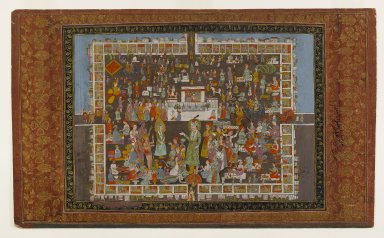
Artist:Indian
Medium: Opaque watercolor and gold on paper
Geograhical Locations:
Dates:1875-1900
Dimensions: Sheet: 11 3/4 x 19 15/16 in. (29.8 x 50.6 cm) Image: 8 7/8 x 12 7/8 in. (22.5 x 32.7 cm)
Collections:
Accession Number: 59.206.7
Image: 59.206.7_IMLS_PS4.jpg,
Catalogue Description: Before one of four city gates an outsized sultan greets a holy personage whose head is set off by a flaming mandoral. Male and female courtiers of every walk of life pay homage to him or carry on with their work. Around the periphery of the city we see the roofs of buildings and rectangles, representing interiors in which the inhabitants work and socialize. In the center of the painting the sultan's white palace is visible, complete with its garden and harem. Despite the oddities of scale and perspective and the unprepossessing style here, the artist has succeeded in illustrating the charming, multifaceted character of traditional Indian life. The topographical view of the palace quarter is a reinterpretation of a convention used in Central Indian and even Nepalese paintings of the nineteenth century to indicate a palace scene. The crowding of figures shown in sizes that extend from large to miniature conveys the rich variety of activity in the bazaar. Specific areas where foods, clothes, and objects are sold are rendered with extraordinary clarity, while even the minuscule figures in the background show such activities as monkey entertainers and figures in palanquins, on elephants, and with bullock carts (set in contemporaneous Hyderabad). In the center of the painting the sultan's white palace is visible, complete with its garden and harem. This swarming activity is contained within a carefully rendered enframement of rectangles, each of which reveals figures pursuing their daily routines. The rigidity of these bands of carefully ruled blocks is relieved by a second border of minuscule buildings depicting the range of architectural styles and purposes in the busy town. Despite the oddities of scale and perspective, the artist has succeeded in illustrating the active, multifaceted character of traditional Indian life. Inscription: In the margin at the right, in Persian, in nastaliq script: "His Excellency, Saint Yusuf, praise and peace be upon him. Hazrat, Jainab, Yusuf, Aleihem al-salawat wa-al-salam."